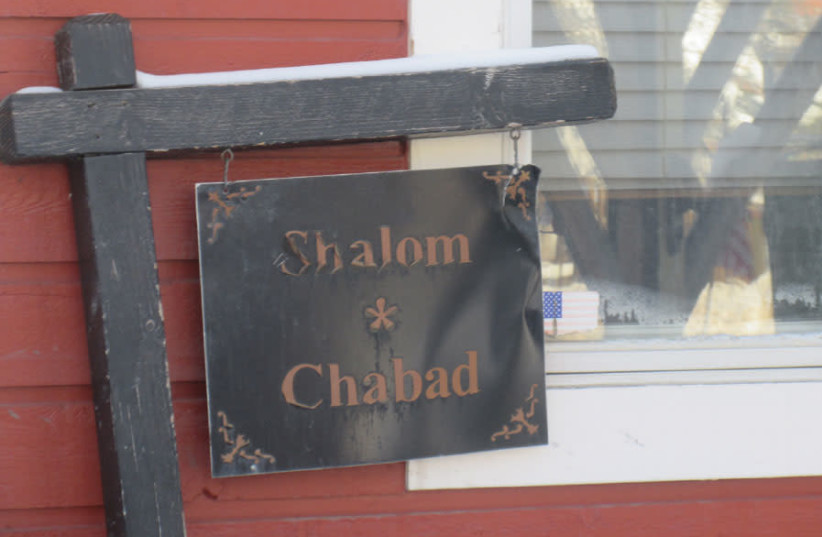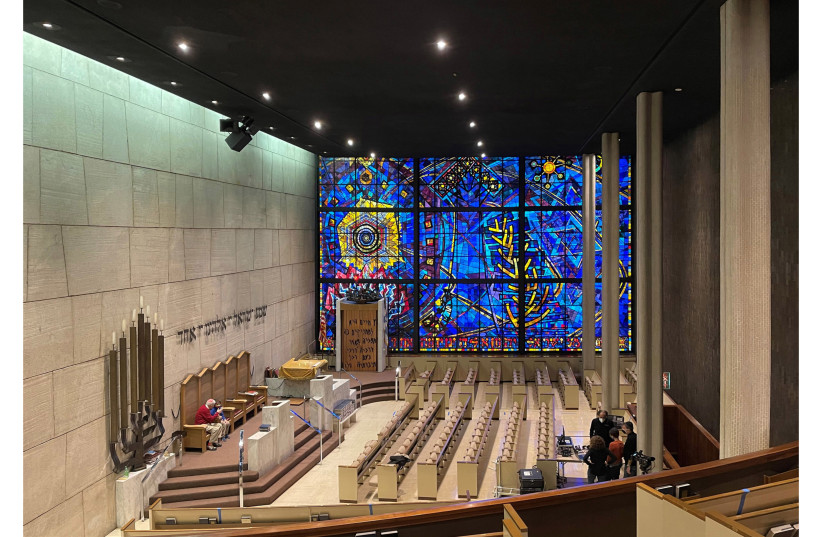Pew Research Center:
"While many Hasidic
groups are growing primarily through procreation, Chabad, focused as it
is on outreach, appears to be picking up a significant chunk of the
Jews who have disaffiliated from the Reform or Conservative movements or
who have never had much of an institutional affiliation to begin with.
In its recent survey, Pew estimated that among Chabad participants, 24%
are Orthodox, while 26% are Reform, 27% are Conservative, and 16% don’t
identify with any particular branch of Judaism."
Chabad bet on more than $137 million in real estate during COVID
A Chicago church was bought by a Chabad emissary couple and will be converted into a synagogue and preschool.

A RUSTIC sign expresses a heartfelt welcome to the Chabad House in Utah
Facing declining membership, a mainline Protestant
congregation in Chicago’s Lakeview neighborhood listed its historic
church complex for sale in the summer of last year. Church leaders were
told it would take at least a year to complete the deal. But within
days, an attractive offer came in, and a few months later the building’s
$2.85 million sale closed.
The buyers were a pair of Chabad
emissaries who had been serving Jews in the North Side neighborhood
from their rented apartment since 2015. By converting the church
complex, the Hasidic couple, Rabbi Dovid Kotlarsky and his wife Devorah
Leah, could now realize their dream of expanding Chabad’s footprint and
establishing a synagogue and preschool.
According
to Chabad.org, key to making the purchase was a $2 million donation
from Chicago tax attorney Jaques Aaron Preis, who heads the Phillip
Leonian and Edith Rosenbaum Leonian Charitable Trust. Preis was quoted
as praising Chabad’s “authenticity” and welcoming attitude.
The
real estate transaction in Lakeview — a hub of Jewish life in Chicago,
where large Reform, Conservative and Orthodox synagogues have long
operated from stately buildings — represents just one of dozens of
investments by Chabad in new buildings or in renovating and expanding
existing properties.
In
some regards, Chabad seems like an anomaly in the Jewish world. Many
non-Orthodox Jewish institutions are unsure about what the future holds
for their physical spaces after a year and a half of largely digital
engagement — and after decades of declining synagogue membership for
Judaism’s largest American denominations. Chabad, meanwhile, whose
strictly Orthodox emissaries seek followers from across the range of
Jewish beliefs and practices, appears to be confident about its capacity
to attract large numbers of people to its centers.

The expansive interior of the Chicago Loop Synagogue includes its famous stained-glass window. Synagogue leadership hopes to turn the congregation, which has fallen on hard times, into a showcase for similar congregation windows
The
movement has embarked on at least $137 million in real estate projects
since the start of the Covid-19 pandemic, according to numbers compiled
by Chabad.org and reviewed by the Jewish Telegraphic Agency.
In
Greenwich, Connecticut, the local Chabad paid $20 million to take over
the site of a Jewish day school that closed last year. In Durham, North
Carolina, a $3 million renovation of a historic inn — supported in part
by Sarah Bloom Raskin, the Duke University law professor who is married
to U.S. Rep. Jamie Raskin — was dedicated last week. And the Chabad at
the University of Illinois is spending more than $7 million to own and
renovate a massive Tudor-style fraternity house.
Because
the thousands of Chabad emissaries around the world fundraise
independently, Chabad’s news and public relations arm had to collect the
data by gathering media reports and by carrying out an informal survey,
according to Rabbi Motti Seligson, a Chabad spokesperson.
The
survey turned up a number of capital projects that have not yet been
publicly announced, including some purchases that are underway now.
Seligson said the true extent of Chabad’s recent real estate expansion
is likely much larger than the $137 million figure indicates.
But
he said he wanted to release the information he had in conjunction with
the 38th annual International Conference of Chabad-Lubavitch
Emissaries, which takes place this week in-person in and around
Brooklyn, New York. as well as virtually.
“We
were doing an exploration of Chabad’s impact and growth to examine the
effectiveness of various programs through this difficult time of the
pandemic,” he said. “These numbers came into sharp focus as we looked at
the level of engagement and our institutional and infrastructure
growth.”
Seligson
also pointed out that during the pandemic, Chabad minted 250 new
emissary couples who went out to serve existing Chabad centers or
establish new ones.
Even
before the pandemic growth spurt, Chabad had already engaged some 37%
of American Jewish adults in activities, according to recent survey data
from the Pew Research Center.
Over
the past 20 years, the number of Chabad synagogues in the United States
has nearly tripled, reaching 1,036 in 2020, according to a tally by
Joel Kotkin, a Chapman University professor who studies demographic
trends, and independent researcher Edward Heyman. Over that same period,
the overall number of synagogues declined by 29%.
“While
their secular counterparts are shrinking, the Hasidim and other more
traditionally observant Jewish communities in America are experiencing a
surge of growth,” Kotkin and Heyman wrote in a Tablet magazine article
analyzing their data.
While many Hasidic
groups are growing primarily through procreation, Chabad, focused as it
is on outreach, appears to be picking up a significant chunk of the
Jews who have disaffiliated from the Reform or Conservative movements or
who have never had much of an institutional affiliation to begin with.
In its recent survey, Pew estimated that among Chabad participants, 24%
are Orthodox, while 26% are Reform, 27% are Conservative, and 16% don’t
identify with any particular branch of Judaism.
“In
the present the core social needs of the Jewish world are filled by two
kinds of organizations: One is Chabad, which is expanding rapidly and
offers a full gamut of services,” Kotkin and Heyman wrote. (The other
kind of organization is the local Jewish federation and its affiliated
Jewish community centers.)
As
Chabad proliferates, it is finding among the Jews it serves many
willing donors. Sometimes, individual contributors like the Preisses in
Chicago play an outsized role, but their gift was accompanied by
$500,000 in small donations, according to Chabad.org.
In
comments to Chabad.org, the Preisses explained why they gave to Chabad.
“They focus on each mitzvah without criticizing. They’re so welcoming,”
said Jacques Preis, who was raised Reform. “It’s not a diluted
Judaism,” said Evelyn, his wife.
“Much
of the funding for these campaigns is raised locally from people whose
lives are personally enriched by Chabad in their community,” Seligson
said. “They represent people from large donors to large numbers of small
donors like college students who are committed to supporting Jewish
life and programs that inspire them with whatever they can based on
their means.”





